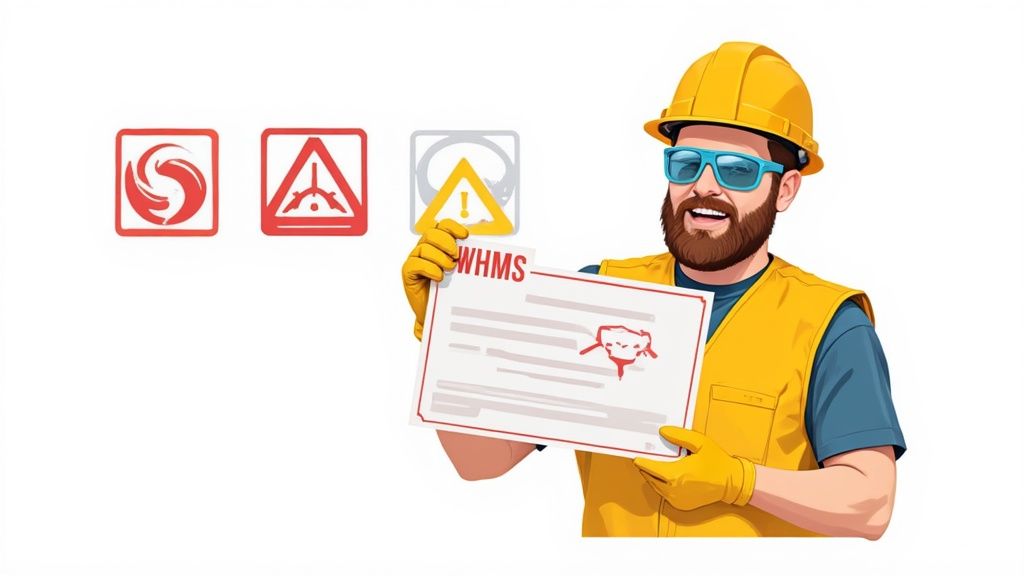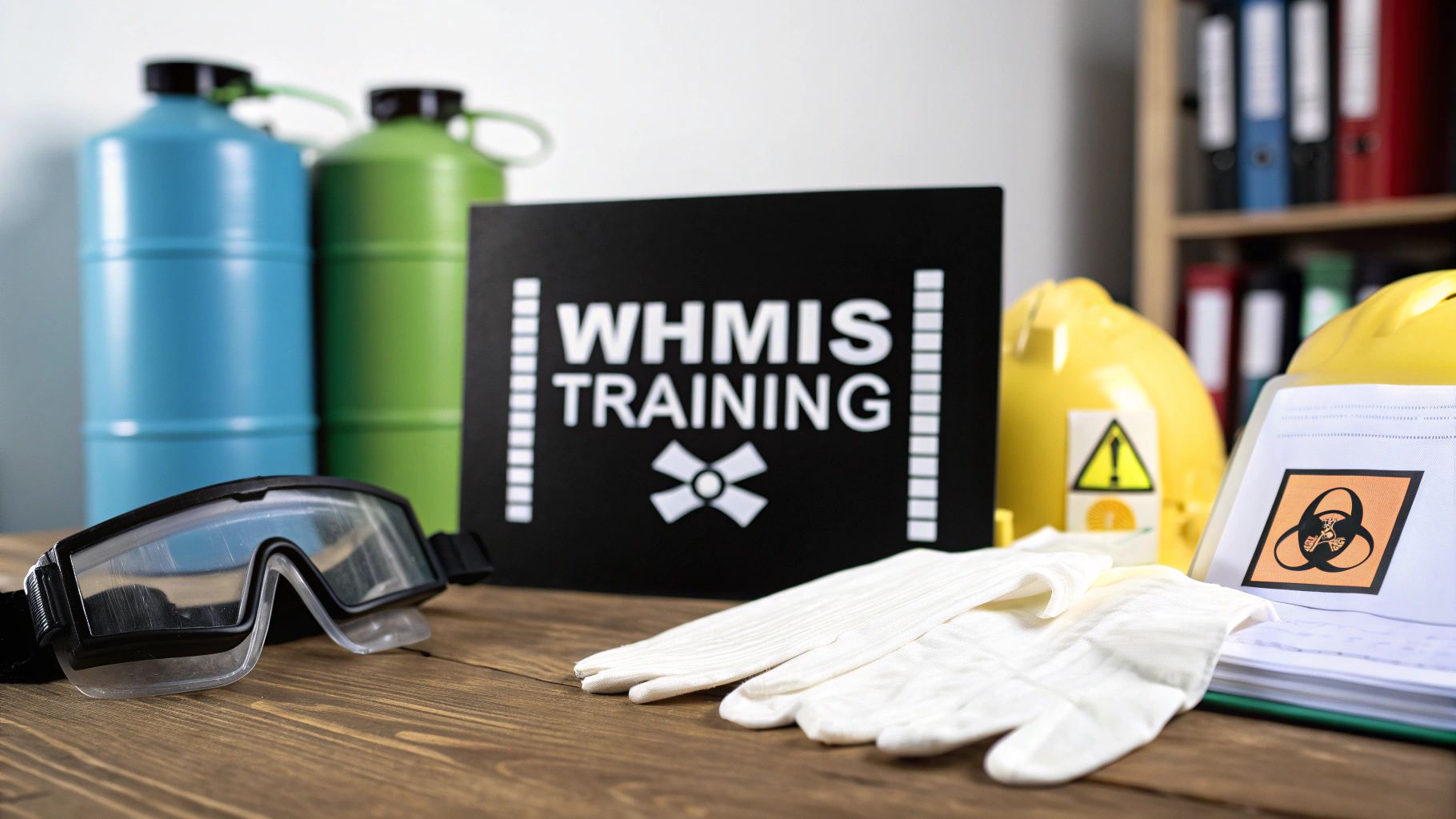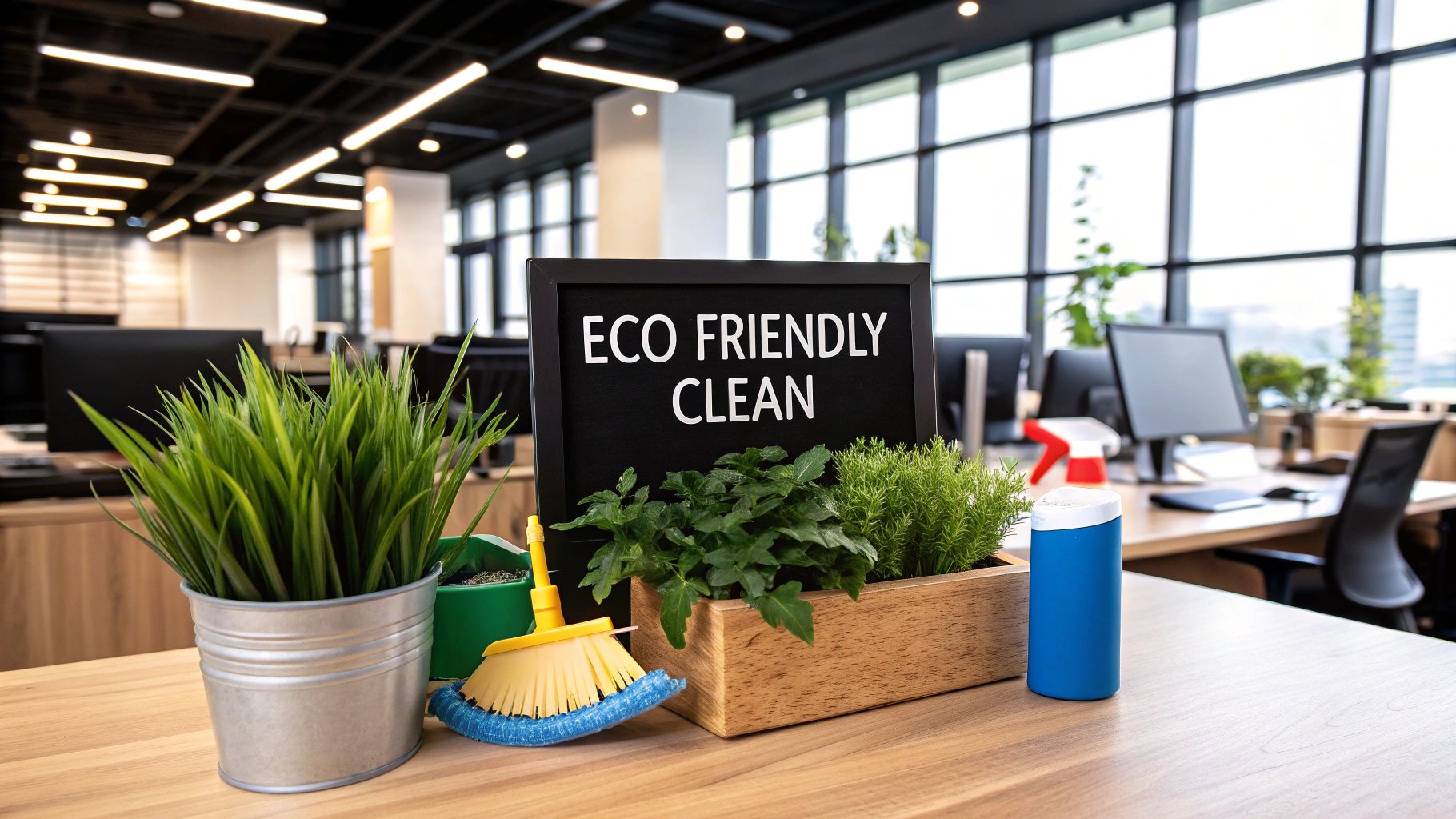Let's get straight to it. WHMIS certification is simply proof that a worker has completed training on Canada's system for hazardous workplace materials. The easiest way to think of it is like a driver's licence, but for handling chemicals and other dangerous substances on the job.
What WHMIS Certification Really Means for Your Workplace
WHMIS certification is so much more than a piece of paper. It’s a vital safety program designed to give you the knowledge to read warning labels, understand Safety Data Sheets (SDSs), and follow the right procedures to prevent injuries.
This certification is mandatory for countless Canadian workers because it empowers them to spot dangers, protect themselves, and help create a safer environment for everyone around them.
The whole point of the Workplace Hazardous Materials Information System (WHMIS) is to create a standardized communication system. Before WHMIS came along, hazard information was all over the map, leaving workers guessing and vulnerable. Now, the system ensures everyone, from professional office cleaning crews to manufacturing teams, speaks the same safety language.
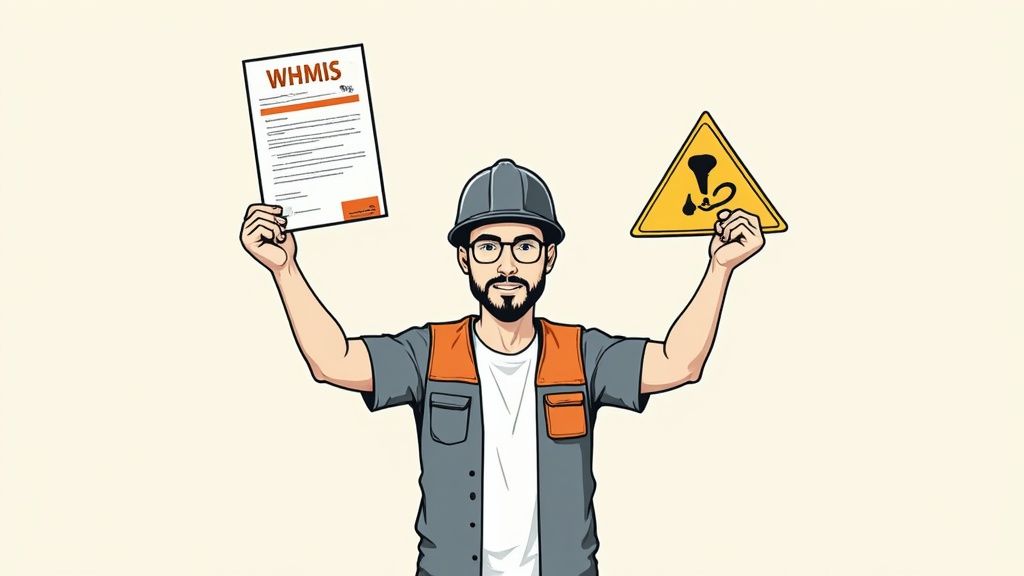
The Core Components of WHMIS
To really get what WHMIS certification is all about, you need to understand its three core parts. They all work together to keep people safe.
To make it easier to grasp, here’s a quick summary of the essential parts of the WHMIS system.
WHMIS At a Glance: The Core Components
| Component | What It Is |
|---|
| Hazardous Product Labels | These are your first line of defence. They give you immediate, at-a-glance warnings on containers using specific symbols and text. |
| Safety Data Sheets (SDSs) | Think of these as the detailed biography of a hazardous product. They offer in-depth info on handling, storage, and what to do in an emergency. |
| Worker Education & Training | This is where it all comes together. It’s the hands-on training where employees learn how to actually use the labels and SDSs in their specific jobs. |
Each of these pieces—the quick-scan labels, the detailed data sheets, and the practical training—forms a complete safety net, ensuring everyone has the information they need, when they need it.
The Journey From WHMIS 1988 to Today’s Standard
The Workplace Hazardous Materials Information System (WHMIS) we know today wasn't built in a day. The story starts back in 1988 with a solid, distinctly Canadian system designed to keep workers safe from hazardous materials. For years, it did its job well, but only within our borders.
As businesses started trading more globally, a patchwork of different safety rules from country to country became a real headache. A chemical might be labelled as hazardous in Canada but not somewhere else, creating confusion, trade barriers, and serious safety gaps. It became clear that a single, unified approach was needed.
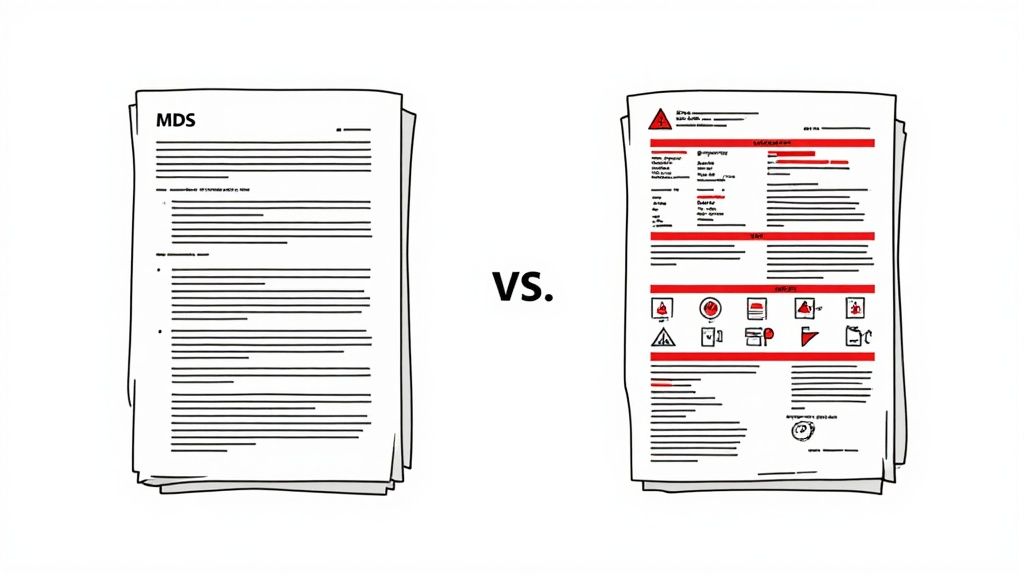
This is where the big shift happened. In 2015, WHMIS got its most significant update when it aligned with the Globally Harmonized System of Classification and Labelling of Chemicals (GHS). This new system, known as WHMIS 2015, brought in standardized hazard classifications, new pictograms, and an updated format for Safety Data Sheets (SDS), which replaced the old Material Safety Data Sheets (MSDS).
This wasn't just a simple name change; it was about creating a common language for chemical safety worldwide. You can find more detail on this critical update and what it means for the WHMIS certificate requirements for 2025.
Key Upgrades From WHMIS 1988 to WHMIS 2015
The goal was simple but ambitious: make sure a warning label from Germany means the exact same thing in a warehouse in Mississauga.
Here are the most important improvements that came with WHMIS 2015:
- Standardized Hazard Classification: GHS introduced specific criteria for classifying physical and health hazards. This created much-needed consistency, no matter where the product was made or used.
- Universal Pictograms: The old circular WHMIS symbols were swapped out for globally recognized pictograms inside a red, square-shaped border. Now, anyone can recognize a hazard at a glance, regardless of what language they speak.
- Safety Data Sheets (SDS): The old 9-section MSDS was replaced by a more detailed, standardized 16-section SDS. This makes finding critical safety information—whether you’re in a dental office or on a factory floor—faster and more reliable.
By adopting GHS, Canada not only made our workplaces safer but also simplified things for businesses that operate on the world stage. It’s all about making safety information clearer, more consistent, and easier for everyone to understand.
Understanding the Three Pillars of WHMIS Safety
The real strength of WHMIS certification is how it breaks down a complex topic into a simple, three-part system. These three pillars work hand-in-hand to build a safety net, making sure every single worker has the info they need to handle hazardous materials without incident.
Think of it like a three-legged stool—if you take one leg away, the whole thing comes crashing down.
The first pillar is product labelling. Labels are your first line of defence, giving you an immediate, on-the-spot heads-up. They use instantly recognizable pictograms and straightforward text to warn you about a product’s dangers at a glance. You'll generally see two types: detailed supplier labels on the original containers and simpler workplace labels for smaller bottles you might fill on-site.
Next up is the Safety Data Sheet (SDS). If the label is the headline, the SDS is the full story. It’s a detailed, 16-section document that digs deep into everything you could possibly need to know—from first-aid steps and fire-fighting instructions to how to store and dispose of the product safely. The SDS is the ultimate guide for any hazardous product on your worksite.
This infographic shows just how these pieces fit together.
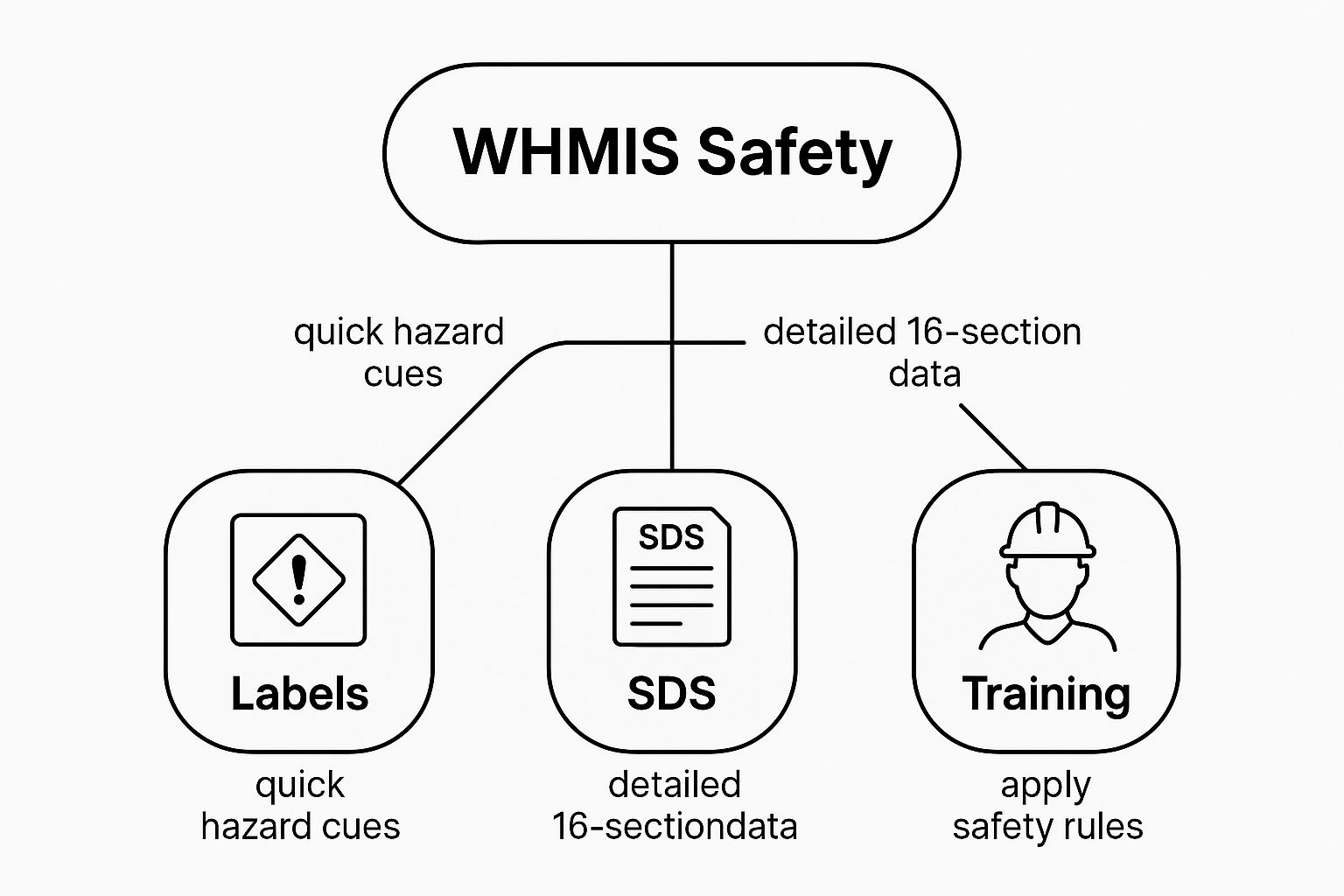
As you can see, labels, data sheets, and training aren’t separate things. They’re interconnected parts of one complete system, each one reinforcing the others.
Education and Training: The Final Pillar
Finally, we have the third—and arguably most important—pillar: worker education and training. This is where the rubber meets the road. Knowing what a label means or where to find an SDS is one thing, but training is what teaches you how to actually use that information in your specific environment.
For instance, our teams providing professional office cleaning must know precisely how to handle the specific disinfection products they use every day. You can learn more about our own strict safety protocols in our guide to commercial disinfection and sanitizing services.
This final step is what turns passive knowledge into active, life-saving habits. To take safety even further, some organizations are now exploring advanced AR safety programs that help employees recognize hazards in real time. Because without proper training, the first two pillars are just paper. With it, they become powerful tools that prevent workplace accidents and injuries.
How to Read the Signs: Decoding WHMIS Pictograms
Those red-bordered symbols you see on chemical labels? Those are WHMIS pictograms, and they’re your first line of defence in staying safe. Think of them like road signs for hazardous materials—they give you an instant, visual warning about the specific dangers a product poses, no reading required.
Learning to read these symbols is a fundamental skill. It’s not about memorizing a dry list; it's about understanding the story each pictogram tells. The exploding bomb, for instance, isn’t just a picture—it’s a clear warning that a product could detonate. The skull and crossbones tells you a substance can be fatal or cause severe toxicity, even with a tiny amount of exposure.
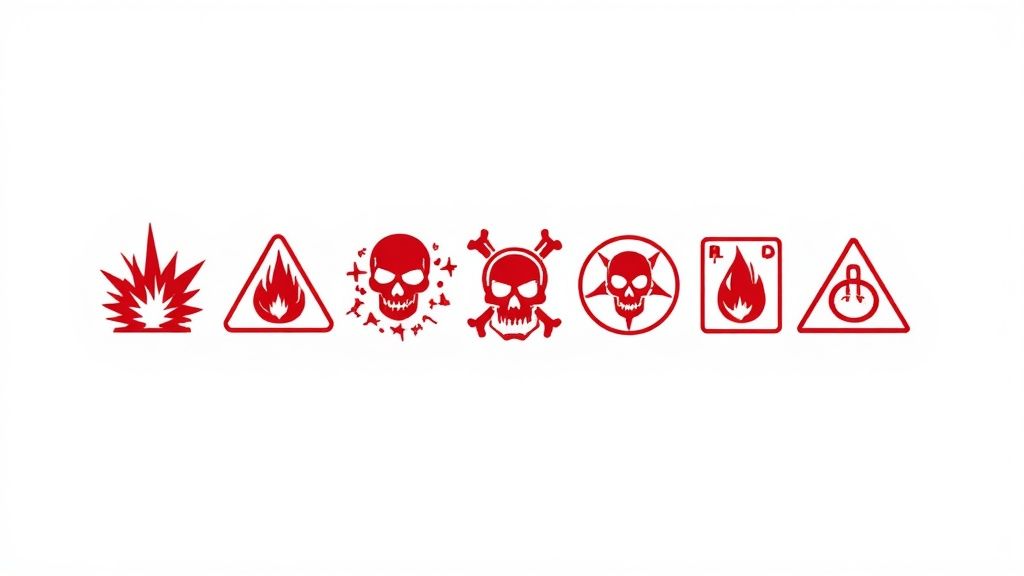
To make things even clearer, WHMIS organizes all potential hazards into two main groups. This simple breakdown helps you quickly understand the type of risk you're dealing with.
- Physical Hazards: These are dangers that come from the product's physical or chemical properties. We’re talking about things like flammability, reactivity, or the potential to corrode metals.
- Health Hazards: This group covers any way a product can harm your health, either right away or over a longer period. This includes everything from skin irritation and respiratory damage to cancer-causing properties.
Every single pictogram falls into one of these two categories, giving you immediate context. That familiar flame symbol? It’s a classic physical hazard, plain and simple.
A pictogram’s red, diamond-shaped border is no accident—it's designed to grab your attention instantly. The symbols inside are standardized globally under the GHS, which means a hazard is recognized the same way whether you’re in Toronto or Tokyo.
We’ve put together a handy table below to break down each symbol, what it represents, and where you might encounter it.
WHMIS 2015 Pictograms and What They Mean
This table is your quick reference guide to the key symbols you'll see on product labels. Getting familiar with them is a huge step toward a safer work environment.
| Pictogram (Symbol Description) | Hazard It Represents | Common Examples |
|---|
| Flame | Fire hazards | Flammable gases, aerosols, liquids, or solids that can easily ignite. |
| Flame Over Circle | Oxidizing hazards | Products that can cause or contribute to the combustion of other materials. |
| Gas Cylinder | Gases under pressure | Compressed gas, liquefied gas, or dissolved gas that may explode if heated. |
| Corrosion | Corrosive damage | Materials that cause skin corrosion/burns, serious eye damage, or are corrosive to metals. |
| Exploding Bomb | Explosion or reactivity hazards | Self-reactive substances or organic peroxides that may explode. |
| Skull and Crossbones | Acute toxicity (fatal or toxic) | Can cause death or severe toxicity with short exposure through any route (inhalation, skin, ingestion). |
| Health Hazard | May cause serious health effects | Carcinogens, mutagens, respiratory sensitizers, or substances with reproductive toxicity. |
| Exclamation Mark | Less serious health effects | Irritants (skin and eye), skin sensitizers, or harmful if swallowed. |
| Biohazardous Infectious Materials | Organisms that can cause disease | Bacteria, viruses, fungi, or other microorganisms that can cause disease in people or animals. |
| Environment (non-mandatory) | Aquatic toxicity | May cause damage to the aquatic environment. |
Remember, recognizing these symbols at a glance is the goal. A quick look at a label should be all it takes to know what precautions you need to take before you even open the container. For more visual learning tools, check out our collection of commercial cleaning infographics to help keep these symbols fresh in your mind. It’s a small bit of knowledge that makes a massive difference in day-to-day safety.
Who Actually Needs WHMIS Certification
So, who really needs WHMIS certification? The short answer is: a lot more people than you’d probably guess.
WHMIS isn't just for chemists in lab coats surrounded by bubbling beakers. If your job puts you in contact with hazardous products—even ones that seem common—you almost certainly need this training. It’s not about ticking a box; it’s a practical necessity for keeping everyone safe on the job.
This rule applies across a huge range of industries. People working in manufacturing, automotive shops, healthcare, and even hair salons handle products that fall under WHMIS regulations every single day. The goal is simple: protect employees from harm and make sure employers are meeting their legal safety duties.
From the Factory Floor to the Front Office
Think about all the real-world situations where WHMIS knowledge is critical. A mechanic using solvents to clean parts, a dental hygienist working with disinfectants, or a professional cleaner handling industrial-strength products all face potential exposure. Each of them needs to know exactly what they’re working with and how to handle it safely.
For example, our professional commercial cleaning teams are trained on every single product they use, from the standard sprays for an office to the heavy-duty solutions needed elsewhere. This knowledge is what allows them to work safely in all sorts of environments, whether it’s an engineering firm, a law office, or a medical clinic. Every workplace is different, which makes job-specific training an absolute must.
Here’s a good rule of thumb: if a product at your workplace has a WHMIS label, anyone who works with or near it needs WHMIS certification. This isn’t just a recommendation—it’s a legal requirement to ensure a safe environment for everyone.
This kind of training becomes even more crucial in places with complex or potent materials. To get a better sense of how we put these safety principles into practice in demanding settings, take a look at our approach to industrial facility and manufacturing cleaning. This deep commitment to safety and training is how we provide both a clean workspace and total peace of mind.
Getting Your Team Certified and Staying Compliant
So, how do you actually get your team WHMIS certified? The good news is, the process is pretty straightforward, with a few key options to fit how your team works best. You can go with self-paced online courses for maximum flexibility or opt for interactive, in-person workshops if you want more hands-on learning.
No matter which path you choose, a solid course will always cover the core WHMIS pillars, spell out worker responsibilities, and walk through emergency procedures. This isn't just a box to tick—it’s about making sure everyone has the fundamental knowledge to handle hazardous products safely.
Choosing the Right Training Method
For most businesses, online training is the most convenient and effective route. These courses let employees learn at their own pace and can be completed from just about anywhere, which means less disruption to your day-to-day operations.
In-person workshops, on the other hand, really shine when you need a more hands-on experience. This format is perfect for teams that handle highly specialized or complex hazardous materials, as it gives people a chance to ask specific questions and see practical demonstrations. Both methods are completely valid; the best choice really boils down to your specific workplace hazards and team structure.
Renewal and Staying Up to Date
One of the questions that comes up all the time is about renewals. While there isn't a single, federally mandated expiry date for a WHMIS certificate, thinking of it as a one-and-done deal is a major mistake. The world of workplace safety is always changing, with new products and updated regulations coming out all the time.
WHMIS certification is a critical piece of the puzzle for workplace safety and compliance. To get a better sense of what goes into building a successful safety program, it helps to understand the principles behind effective training in compliance.
As a best practice, most employers and provincial regulations now require annual refresher training. It’s a proactive approach that keeps everyone’s knowledge sharp and ensures your business stays compliant. Staying current is especially critical right now, as suppliers have until December 14, 2025, to fully switch over their product classifications and Safety Data Sheets to meet the latest amendments.
This ongoing commitment to education is what empowers your team to safely handle all the necessary cleaning supplies and hazardous products. It’s about more than just knowledge—it’s about turning safety into a sustainable part of your workplace culture.
Got Questions About WHMIS? We Have Answers
To wrap things up, let’s tackle some of the most common questions we hear about WHMIS certification. Here are the clear, straightforward answers you need.
How Long Is WHMIS Certification Good For?
This is a big one. While there isn't a single, federally mandated expiry date, the industry standard is to think of WHMIS certification as an annual check-in. Most employers treat it this way, requiring a refresher course every year to keep everyone's safety knowledge sharp.
That being said, some provinces and territories do have their own specific renewal timelines. The best advice? Always follow your local Occupational Health and Safety (OHS) guidelines and your own company's internal safety policy. That's how you stay compliant.
Is Online WHMIS Training Legit?
Absolutely, and it's become a popular, effective way to get certified. A proper online course will be thorough, completely up-to-date with the latest WHMIS standards, and give you a printable certificate once you pass. It’s convenient and gets the job done.
But here’s the critical part: that online course is just step one. Employers are legally on the hook to provide workplace-specific training on top of it. This follow-up training needs to cover the actual hazardous products your employees will be working with on-site, day in and day out.
The point of WHMIS isn't just to memorize symbols from a screen; it's about knowing what to do when you see one of those symbols on a container in front of you. Generic training teaches the "what," but site-specific training teaches the "how" for your workplace.
What's the Difference Between an SDS and an MSDS?
Think of a Safety Data Sheet (SDS) as the new and improved version of the old Material Safety Data Sheet (MSDS). The biggest change is the format.
- SDS: Follows a strict, internationally recognized 16-section format. This was brought in with WHMIS 2015 and the GHS. The standardized layout makes finding critical info—like first aid measures or what to do in a fire—fast and predictable, no matter who made the product.
- MSDS: The old sheets had a looser format, often with 9 sections, but it could vary from one supplier to the next. This made them inconsistent and harder to use quickly in an emergency.
The SDS is a significant upgrade. MSDSs have been phased out, so by now, you should only be seeing the modern, 16-section SDS format in your workplace.











